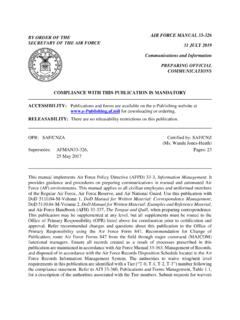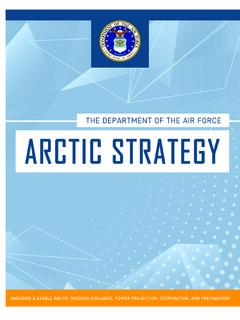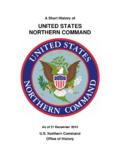Transcription of BY ORDER OF THE AIR FORCE TACTICS, TECHNIQUES …
1 BY ORDER OF THE SECRETARY OF THE AIR FORCE AIR FORCE TACTICS, TECHNIQUES AND PROCEDURES 29 JULY 2021 Tactical Doctrine INSTALLATION MEDICAL ALL HAZARDS RESPONSE (IMAHR) ACCESSIBILITY: Publications and forms are available on the e-Publishing website at for downloading or ordering. RELEASABILITY: There are no release restrictions on this publication. OPR: ACC/SGX Supersedes: AFTTP , 15 October 2013 Certified by: AF/SG3/5X (Col Colin Smyth) Pages: 199 The Air FORCE Tactics, TECHNIQUES , and Procedures (AFTTP) 3-42 series of publications is the primary reference for medical operations. AFTTP provides tactics, TECHNIQUES and procedures (TTP) for installation medical commanders to plan, prepare, and employ their assigned assets for installation medical response to all hazards to include chemical, biological, radiological, and nuclear (CBRN) incidents.
2 These incidents include weapons of mass destruction (WMD) as well as incidents involving the accidental or intentional spill or release of hazardous materials (HAZMAT) and toxic industrial materials (TIMs) and natural events such as earthquakes, hurricanes, and the like. This AFTTP provides essential guidance for Air FORCE Medical Service (AFMS) personnel s initial installation medical response utilizing an all-hazards approach to respond to an incident involving the intentional or accidental release of CBRN. The ability to respond appropriately is critical to mitigating the consequences of an event. Medical commanders should be aware of the necessary steps to ensure maximum survivability and to safeguard mission capabilities. The doctrine in this document is authoritative but not directive. It applies to all Air FORCE military and civilian personnel.
3 It specifically applies to the Installation Medical All Hazards Response (IMAHR) teams that are provided funded equipment sets for Installation Medical All Hazards Response (IMAHR). It provides the individual concepts of operations (CONOPS) for the following Medical Counter-CBRN (MC-CBRN) capabilities: Patient Decontamination Team, Pharmacy Team, Bioenvironmental Engineering (BE) Team, Laboratory Biological Detection Team (LBDT), Field Response Team (FRT), Triage Team, Clinical Team, Manpower/Security Team, and Public Health (PH) Team. Additional IMAHR teams that complement the above teams 2 29 JULY 2021 include the Medical Control Center (MCC), Information Services Disaster Response Team (ISDRT), Patient Administration Team (PAT), Medical Logistics Team, and Disaster Mental Health Team.
4 Reference Response Training & Assessment Program (RTAP) tools for more information about these teams. Air National Guard (ANG) units not co-located with active duty (AD) units employ only the Patient Decontamination (976A), BE (976H), Triage (976K), and PH (976P) allowance standards. In accordance with (IAW) Air FORCE Instruction (AFI) 41-106, Medical Readiness Program Management, ANG units are not required to publish an MCRP. Include all planning for the ANG MC-CBRN capabilities in each wing s Installation Emergency Management Plan (IEMP). Air FORCE Reserve Command (AFRC) BE offices are part of base operations support (BOS) and not the medical unit. AFRC executes the requirements of this AFTTP related to BE and PH responsibilities and the 886H package within the restraints of civilian personnel responsibilities.
5 Some ANG and AFRC installations may not possess the inherent capabilities to provide the response outlined in this publication. Refer recommended changes and questions about this publication to the Office of Primary Responsibility (OPR) using AF Form 847, Recommendation for Change of Publication. Route AF 847 through the appropriate functional chain of command and parent major command (MAJCOM). Ensure that all records created as a result of the processes prescribed in this publication are maintained IAW AFMAN 33-363, Management of Records, and disposed of IAW the Air FORCE Records Disposition Schedule (RDS) located in the Air FORCE Records Information Management System (AFRIMS). The use of the name or mark of any specific manufacturer, commercial product, commodity, or service in this publication does not imply endorsement by the Air FORCE .
6 SUMMARY OF CHANGESThis document has been substantially revised and should be completely reviewed. It incorporates changes necessary to align with recent updates to AFI 41-106 and AFI 10-2501. It incorporates recent strategic realignment efforts, new concepts for biological aerosol monitoring, and includes additional information regarding the Outpatient Decontamination Package. Added updated medical response information and guidance utilizing an all-hazards approach when responding to incidents. Removed information that is referenced in other Air FORCE or DoD 1 INTRODUCTION 8 Purpose.. 8 Air FORCE Guidance.. 8 Planning Considerations.. 8 Chemical, Biological, Radiological, and Nuclear (CBRN) Threat.. 9 Medical Counter-CBRN (MC-CBRN) Response Capabilities.. 10 Organizing and Equipping.. 11 Roles and Responsibilities.. 12 Table Pilot Units/Medical Group (MDG).
7 18 29 JULY 2021 3 Decontamination and Disposal Management.. 18 Security Provisions.. 19 Chapter 2 CASUALTY PREVENTION 20 Casualty Prevention Overview.. 20 Pre-Incident Planning.. 20 Incident Response.. 22 Post-Incident Recovery Actions.. 24 Chapter 3 CASUALTY MANAGEMENT 26 Casualty Management Overview.. 26 Pre-Incident Preparation and Planning.. 26 Planning Considerations.. 27 Overview of MC-CBRN Response Operations.. 30 Figure Overview of MC-CBRN Response Operations.. 31 MC-CBRN Operations at the Incident Site.. 32 MC-CBRN Operations at the Medical Unit.. 33 Guidelines for Triage and Treatment of CBRN Casualties.. 35 Post-Incident Recovery Actions.. 36 Chapter 4 LOGISTICS 38 Medical Logistics Responsibilities.. 38 Allowance Standard (AS) Authorization Levels.. 38 Peacetime Operating Stocks (POS).. 38 Accountability.
8 38 Storage.. 38 Resource Management.. 39 Maintenance.. 39 Sustainment.. 39 Incident Response Procedures.. 39 Post-Incident Response Procedures.. 40 Chapter 5 TRAINING AND EXERCISES 41 Training Overview.. 41 Specialized Team Training.. 41 Training Categories.. 44 4 29 JULY 2021 Professional Training Requirements.. 45 Field Training Exercises (FTX).. 45 Table Top Exercises (TTXs).. 47 Lessons Learned/After Action Reports (AAR).. 47 Chapter 6 COMMUNICATIONS AND INTELLIGENCE 49 Communications Flow.. 49 Communication Systems and Methods.. 49 Intelligence Support.. 50 Response to 50 Chapter 7 PATIENT DECONTAMINATION 51 Introduction.. 51 Capabilities and Limitations.. 52 Concept of 54 Manning.. 57 Integration.. 58 Equipment and Supplies.. 58 Chapter 8 PHARMACY 60 Introduction.. 60 Capabilities and Limitations.
9 61 Concept of 62 Manning.. 64 Integration.. 64 Equipment and Supplies.. 65 Chapter 9 BIOENVIRONMENTAL ENGINEERING (BE) 67 Introduction.. 67 Capabilities and Limitations.. 67 Concept of 69 Manning.. 73 Integration.. 74 Equipment and Supplies.. 75 Table Tiered Approach to CBRN Detection and Analysis.. 77 29 JULY 2021 5 Chapter 10 LABORATORY BIOLOGICAL DETECTION 79 Introduction.. 79 Laboratory Response Network (LRN).. 79 Figure Laboratory Response Network (LRN) Structure.. 80 Capabilities and Limitations.. 81 Concept of 83 Manning.. 86 Integration.. 87 Equipment and Supplies.. 88 Chapter 11 FIELD RESPONSE 89 Introduction.. 89 Capabilities and Limitations.. 90 Concept of 90 Manning.. 93 Integration.. 93 Equipment and Supplies.. 94 Chapter 12 TRIAGE 95 Introduction.. 95 Capabilities and Limitations.
10 95 Concept of 96 Manning.. 97 Integration.. 97 Equipment and Supplies.. 97 Chapter 13 CLINICAL 99 Introduction.. 99 Capabilities and Limitations.. 100 Concept of 100 Manning.. 105 Integration.. 105 Equipment and Supplies.. 106 Chapter 14 MANPOWER/SECURITY 107 Introduction.. 107 6 29 JULY 2021 Capabilities and Limitations.. 107 Concept of 108 Manning.. 109 Integration.. 109 Equipment and Supplies.. 110 Chapter 15 PUBLIC HEALTH 112 Introduction.. 112 Capabilities and Limitations.. 115 Concept of 116 Manning.. 120 Integration.. 120 Equipment and Supplies.. 122 Chapter 16 AIR NATIONAL GUARD (ANG) 123 Introduction.. 123 Purpose.. 123 MC-CBRN Response.. 123 Logistics.. 124 Program 124 Patient Decontamination Team (976A).. 125 Triage Capability (976K).. 130 Bioenvironmental Engineering (BE) Team (976H).















